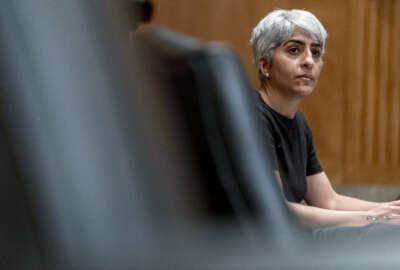Federal boards and councils, do they set the right examples?
The Chief Human Capital Officers Council recently got a revival from the Biden administration. They hope of help modernize the federal workforce.
Best listening experience is on Chrome, Firefox or Safari. Subscribe to Federal Drive’s daily audio interviews on Apple Podcasts or PodcastOne.
The Chief Human Capital Officers Council recently got a revival from the Biden administration. The cheekos are pondering the future of federal work. They’ve rewritten the council’s charter. They hope of help modernize the federal workforce. Our guest on Federal Drive with Tom Temin says the Council needs to model the behaviors it hopes to foster. Joining the Federal Drive, long-time federal workforce guru Bob Tobias.
Interview transcript:
Tom Temin: Bob, good to have you in.
Bob Tobias: It’s nice to see you in person, Tom.
Tom Temin: Yes, for those that are regular listeners know that too, we have been talking by Zoom for a long time and you in a remote house. So it’s good to have you back in the center of things and joining us in the studio, see you in the flesh and you haven’t aged a bit.
Bob Tobias: Thank you Tom.
Tom Temin: All right. So tell us about this idea that CHCO Council, it’s basically a good thing that it’s revived in terms of the federal workforce?
Bob Tobias: Oh, I think it’s a great thing that the CHCO Council has revived and rejuvenated itself. And I think the next step could be to enroll themselves as a group in a good leadership development program, as they suggest to other leaders that they should do, enroll themselves in a good leadership development program.
Tom Temin: And you make a distinction between development and training. And they’re not quite equivalent, correct?
Bob Tobias: They are not the same at all. I’m not talking about skill training, for example, how to fill out a performance evaluation form. I’m talking about helping leaders learn why they are reluctant to conduct difficult conversations, or why they believe a leader is expected to be the smartest technician in the room rather than a person who ensures that every technical voice in the room is heard before a decision is made.
Tom Temin: So the CHCOs in the agencies, at that level, aside from the council, they take care of a lot of, they oversee a lot of process related to the development of people, finding them, ingesting them, having them apply. But they’re not the decision makers necessarily in who gets hired by the government. That’s really the program people that are hiring. So it’s an interesting relationship that the CHCOs have with their agencies. So how can they better improve the hiring and onboarding and development of people that don’t work for them, but work for the agency programs?
Bob Tobias: Well, the CHCO Council makes policy, the individual CHCO seek to implement that policy. And one policy that’s been in effect for a long time is more leadership development opportunities. And if they were to enroll themselves, they’d prove that it’s possible to participate in a leadership development program. Notwithstanding the time it takes to prepare and participate. They’d be able to debunk the myth, particularly high level career leaders say I’m too busy, or I’m too important to be away. I don’t think anybody is too important to be excused from learning how to be a better leader. So many leaders learn how to lead based on their first experience at McDonald’s or Starbucks. And they develop a command and control, a directive, a micromanagement leadership style, that is no longer appropriate nor applicable to the kind of workforce the federal sector is trying to attract. So if other more successful leadership styles exist, and they require an expansion of current thinking to include a greater understanding of why they behave as they do, where it came from, and the adoption of new behavior that includes, for example, knowing really how to delegate authority and responsibility, addressing the needs of those they lead to grow and develop, training, treating team members with kindness and respect, stimulating curiosity and wonder, not automatic rigid declarations and creating a collaborative learning environment where team members learn from each other and are able to solve today’s complex problems. And those are just an example of what can be learned in a successful leadership development program.
Tom Temin: Yes. And because they have such a ambitious agenda for the council, they could develop their own leadership pursuant to getting all that done, and pushing it down through the bureaucracy in an effective way that people are willing to accept.
Bob Tobias: They could, they could. And some leaders will say, well I know all about that. And to those I say, you who have already learned and are applying new leadership styles, your behavior would be validated, and you’d be encouraged to do more. And all leaders in a leadership development program learn language that helps to better understand themselves, their ability to provide an explanation to those they lead, why they’re changing and language to support the development of those they lead. So this would be good for every leader at every level.
Tom Temin: We’re speaking with Bob Tobias, a professor in the Key Executive Leadership Program at American University. And by modeling good leadership behavior, and getting this kind of behaviors, the ones you outlined, throughout the government, that would ensure the next generation of leaders is better, because they would have better role models. I can remember early in my own career, I worked for a man whose leadership style was superb, and helped me a great deal later on. The guy he worked for that later became my direct boss was a micromanager that nobody liked. But side by side, you can really A/B different types of leaders and know which are better at developing people in which are just having people follow orders in fear.
Bob Tobias: Yeah, it’s it’s much easier for me, Tom, if I’ve experienced the kind of extraordinarily narrow leader I’ve described, rather than being limited to a command and control type, because then I know what it feels like, I know what the behavior I need to model. But if I only read about it in a book or try to imagine it, it’s much more difficult to implement.
Tom Temin: Alright. While we have you, I just want to switch gears for a minute. The return to work, the return to the office is very much up in the air, how that’s going to look like for the federal government. It seems to be bifurcating into a plan of managers and executives coming back to the office with some regularity, but not the rank and file, our own Nicole Ogrysko has been reporting on this. And one of the reasons is the union management negotiations over this are not going well. And this from an administration that, as I put it, can’t say the word job without having the word union in front of it. What do you make of what’s going on?
Bob Tobias: I think that this is a natural progression of coming back to work. These items are negotiable. Union leaders when they left the workplace were facing managers who refused to even talk about any kind of a hybrid system or working at home. And now they’re being asked to come back to work with the same managers. Trust has to be created. Language has to be created. And my expectation is it’s going to work out just fine.
Tom Temin: It sounds like the line from an old crime and trial movie that I believe was delivered by Sir Laurence Olivier, when you had managers that before pandemic didn’t want anybody to telework, you got to be there so I can count the noses. Now, then the pandemic came, and they asked everyone to telework or forced everyone to telework. And now they want some kind of a hybrid. So what do they really want is Sir Lawrence would have said, which one was the lie? That’s a little harsh.
Bob Tobias: It is a little harsh, but it does take some trust. Now that the rules obviously have to change. It takes some trust to define those rules in a way that makes sense for people who can work at home, and yet there are a lot of problems with working at home in terms of getting job opportunities, building social capital, and all these issues have to be worked out.
Tom Temin: Alright, well, let’s hope they get worked out because it’s a changing, morphing situation. Bob Tobias is professor in the Key Executive Leadership Program at American University. As always, thanks so much.
Bob Tobias: Thank you, Tom. It’s a pleasure to be here.
Copyright © 2025 Federal News Network. All rights reserved. This website is not intended for users located within the European Economic Area.
Tom Temin is host of the Federal Drive and has been providing insight on federal technology and management issues for more than 30 years.
Follow @tteminWFED





